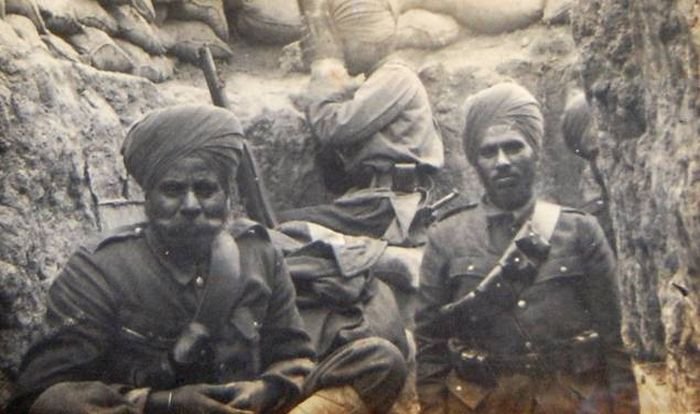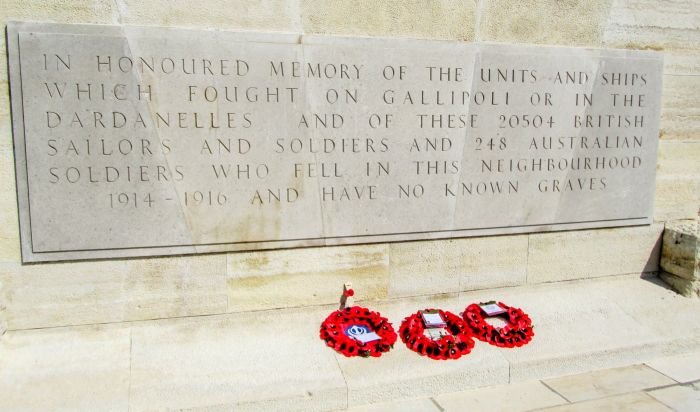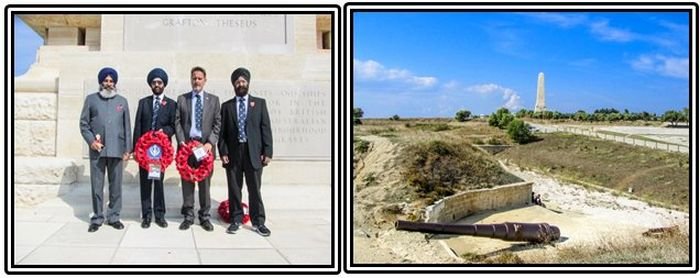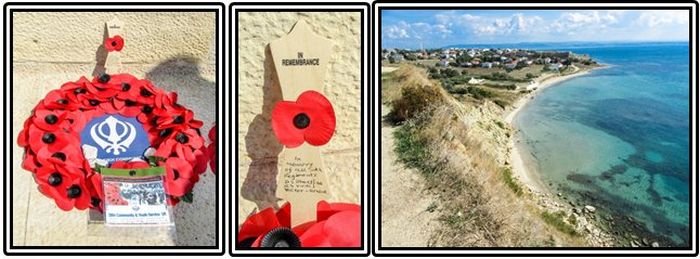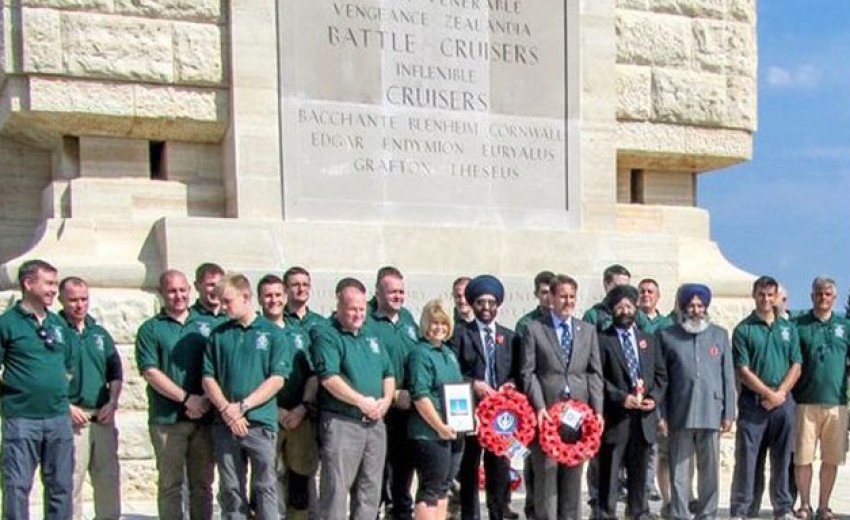First Sikhs Remembrance Visit to Helles Memorial in Gallipoli, Turkey
October 19, 2015: On Wednesday 7th October 2015 Sikhs from UK and Greece made the first remembrance visit to the Helles Memorial in Gallipoli, Turkey and paid respects to the soldiers who made the ultimate sacrifice and died for Europe's freedom during World War I. Mr David Bennett, regional supervisor for Turkey from Commonwealth War Graves Commission and his colleague were also present.
As far as we know no Sikh has officially visited the Helles Memorial for remembrance since it was built in 1924. Mr Bennett and his local supervisor confirmed that they have never seen any Sikhs at this site. Initiative was taken for this remembrance visit by Mr Ranvir Singh Virdi and Mr Dal Singh Dhesy, members of the Royal British Legion, Birmingham, and of Sikh Community and Youth Services, UK. Contacts were made with the Turkish Commonwealth War Graves Commission and with Mr Jagpravash Singh (Victor) President of Shiri Guru Nanak Darbar, Tavros, Athens, Greece who also joined to pay their respects to the fallen soldiers. All participated in a remembrance ceremony and paid homage to the fallen soldiers of WW1 in Gallipoli by laying a wreath on behalf of SCYS and RBL.
The Helles Memorial is a Commonwealth War Graves Commission war memorial near Sedd el Bahr, Turkey. The memorial serves the dual function of being a Commonwealth battle memorial for the whole Gallipoli Campaign and place of commemoration for 20,885 Australian, British and Indian servicemen who died in all three sectors of the peninsula and have no known grave. The memorial takes the form of an obelisk and is over 30 metres high.
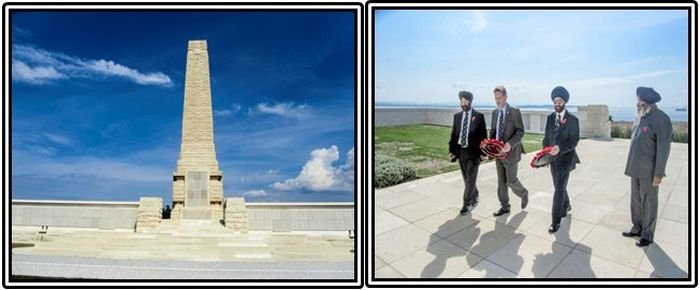
On this occasion an Irish delegation led by Carol Walker, The Somme Association, from Ireland was also present at the memorial that joined in the Act of Remembrance and paid their respects. They also specifically had a separate remembrance ceremony to commemorate the sacrifice of the 10th (Irish) Division. This was conducted by Reverend Mark Donald (Padre 2nd Battalion The Royal Irish Regiment). The presence of Sikhs and Irish in the same remembrance ceremony with representatives of CWGC was very unique, which was respected and appreciated by everyone present. It was great honour to meet this group. On this occasion a presentation in memory of Sepoy Dewa Singh, who died in the Gallipoli conflict on 7th October 1915 exactly 100 years ago, was made to Mr David Bennett of CWGC. Dewa Singh, Son of Dal Singh of Nawi Talwandi, Jagraon, Ludhiana, Punjab, service number 4336, was with the 14th King George's Own Ferozepore Sikhs. He's remembered with honour on panel 256 to 262.
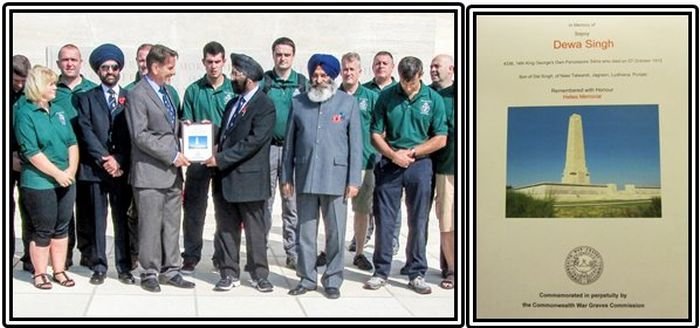

Historical Information
By early 1915, the war on the Western Front had reached a stalemate. The Gallipoli campaign was intended to break the deadlock. In the spring of 1915, Allied warships bombarded the peninsula's costal forts and attempted to force their way through the narrow Dardanelles Straits, controlled by the forces of the Ottoman Empire. On 18th March, three Allied battleships were lost to mines and naval attack was abandoned.
A 70,000 strong Mediterranean Expeditionary Force was assembled, comprising British, Canadian, Indian and French troops, along with the Australian and New Zealand Army Corps (ANZAC). Its mission was to seize the peninsula, opening the Straits for Allied warships which could attack Constantinople (now Istanbul), taking the Ottoman Empire out of the war, and opening up a route to provide Russia with much needed supplies.
The Allies landed on the peninsula on 25-26 April 1915; the 29th Division at Cape Helles in the south and the Australian and New Zealand Corps north of Gaba Tepe on the west coast, an area known as Anzac. On 6 August, further landings were made at Suvla, just north of Anzac, and the climax of the campaign came in early August when simultaneous assaults were launched on all three fronts. However, the difficult terrain and stiff Turkish resistance soon led to the stalemate of trench warfare. From the end of August, no further serious action was fought and the lines remained unchanged. Despite a major offensive in August 1915, the Allies were unable to break the deadlock. An evacuation began in December and on 9th January 1916, the last Commonwealth soldier left the peninsula.
The United Kingdom and Indian forces named on the Helles memorial died in operations throughout the peninsula, the Australians at Helles. There are also panels for those who died or were buried at sea in Gallipoli waters. The memorial bears more than 21,000 names.

Few of us are aware of the role Sikh soldiers played in the Gallipoli campaign that ran from April 25, 1915 to January 9, 1916.
Being subjects of the Crown under British rule in India, Sikhs and Indians had no choice but to participate in WW1, a war that was certainly not of their making and a war that they were sent to fight in simply because they were recruits of the British Indian Army.
The Gallipoli campaign cost the lives of some 36,000 Commonwealth, 10,000 French and at least 86,000 Turkish troops. 1,358 Indians died and some 3,421 were injured in the Gallipoli campaign.
Records tell us that 371 who died fighting at Gallipoli on June 3 and 4, 1915, were from the battalion of the 14th Sikh regiment. General Sir Ian Hamilton was in charge of the troops against the Turks during that operation and he wrote glowingly of this regiment that fought valiantly.
In a letter to his Commander-in-Chief back in India, he wrote: "In spite of the tremendous losses there was not a sign of wavering all day. Not an inch of ground was given up and not a single straggler came back.
"The ends of the enemy's trenches were found to be blocked with the bodies of Sikhs and of the enemy who died fighting at close quarters, and the glacis slope was thickly dotted with the bodies of these fine soldiers all lying on their faces as they fell in their steady advance on the enemy.
"The history of Sikhs affords many instances of their value as soldiers, but it may be safely asserted that nothing finer than the grim valour and steady discipline displayed by them on the 4th of June has ever been done by soldiers of the Khalsa.
"Their devotion to duty and their splendid loyalty to their orders and to their leaders make a record their nation should look upon with pride for many generations."
The names of the 14 K.G.O. Ferozepore Sikhs, 15th Ludhiana Sikhs, 51st ,53rd 54th Sikhs and others are on the panels at the Helles memorial. 56th Punjabi rifles, 90th, 92nd ,66th, 69th,89th Punjabies, 28th Mountain Battery, 23rd Peshawar MTN.BTY, 26th Jacob's MTN.BTY, 27th Mountain Battery, Indian Army Res of offrs and 21st Kohat MTN BTY are some panels in which Sikh names are engraved.

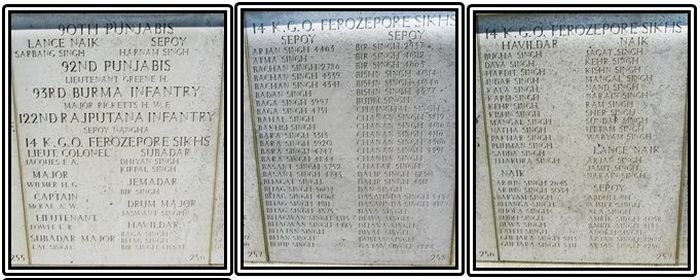
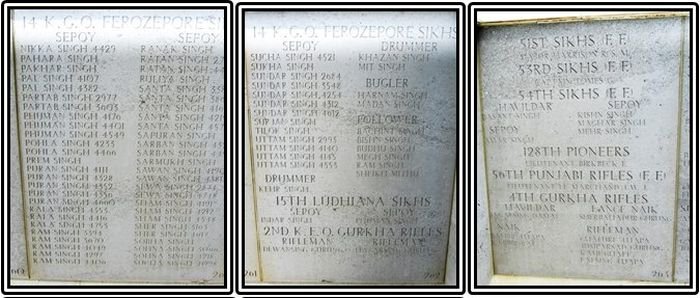

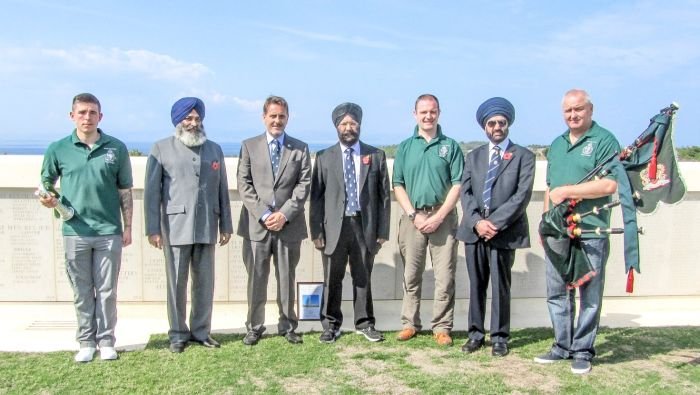
The Ferozepur Sikhs fought true to their reputation. In the Battle of Krithia, they led frenzied charges on Terkish trenches. A Times of India (newspaper) detailed how the Sikhs, despite facing heavy losses in face of heavy machinegun and rifle fire, led a bayonet charge on the Turkish trenches facing them and killed the defenders. But this bravery cost them dear: the battalion lost 82% of its strength and had to be attached to a Gurkha battalion until they were reinforced by Patiala state troops.
We must make special efforts to perpetuate the memory of all the valiant soldiers who laid down their lives including the Sikh regiments that fought alongside the Australian and New Zealanders at Gallipoli.
It makes me wonder if the Sikh soldiers knew in which part of the world they were in when they died.
Remembering and honouring the fallen is the greatest tribute we can give to all those who gave their lives for our tomorrow. The purpose of the remembrance gathering is also to raise awareness. We need to know that the Sikh soldiers also made a contribution, similar to other nations of the world, to help bring peace and freedom for people in Europe by sacrificing their lives in large numbers, especially in Gallipoli.
Who were these Sikhs and from where did they come? The Commonwealth War Graves Commission has a website www.cwgc.org that makes the information available to those who are interested. It has a registry that mentions the name of each decedent, their rank, service number, date of death, age, regiment or unit in which he serviced, grave or memorial reference, place of origin and name of father or wife.
